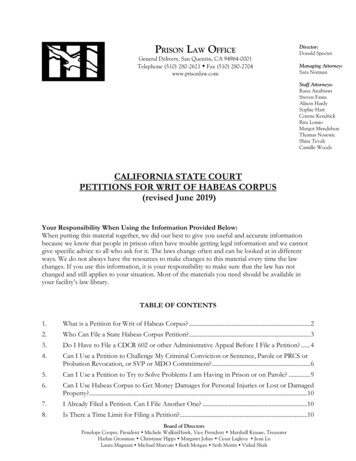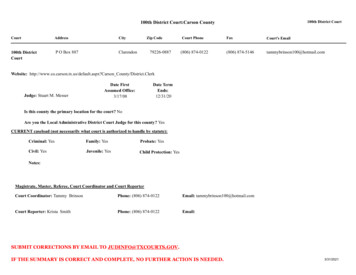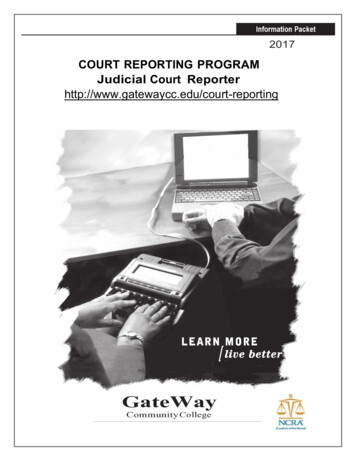
Transcription
PRISON LAW OFFICEGeneral Delivery, San Quentin, CA 94964-0001Telephone (510) 280-2621 Fax (510) 280-2704www.prisonlaw.comDirector:Donald SpecterManaging Attorney:Sara NormanStaff Attorneys:Rana AnabtawiSteven FamaAlison HardySophie HartCorene KendrickRita LomioMargot MendelsonThomas NosewicShira TevahCamille WoodsCALIFORNIA STATE COURTPETITIONS FOR WRIT OF HABEAS CORPUS(revised June 2019)Your Responsibility When Using the Information Provided Below:When putting this material together, we did our best to give you useful and accurate informationbecause we know that people in prison often have trouble getting legal information and we cannotgive specific advice to all who ask for it. The laws change often and can be looked at in differentways. We do not always have the resources to make changes to this material every time the lawchanges. If you use this information, it is your responsibility to make sure that the law has notchanged and still applies to your situation. Most of the materials you need should be available inyour facility’s law library.TABLE OF CONTENTS1.What is a Petition for Writ of Habeas Corpus? . 22.Who Can File a State Habeas Corpus Petition?. 33.Do I Have to File a CDCR 602 or other Administrative Appeal Before I File a Petition? . 44.Can I Use a Petition to Challenge My Criminal Conviction or Sentence, Parole or PRCS orProbation Revocation, or SVP or MDO Commitment? . 65.Can I Use a Petition to Try to Solve Problems I am Having in Prison or on Parole? . 96.Can I Use Habeas Corpus to Get Money Damages for Personal Injuries or Lost or DamagedProperty?.107.I Already Filed a Petition. Can I File Another One? .108.Is There a Time Limit for Filing a Petition?.10Board of DirectorsPenelope Cooper, President Michele WalkinHawk, Vice President Marshall Krause, TreasurerHarlan Grossman Christiane Hipps Margaret Johns Cesar Lagleva Jean LuLaura Magnani Michael Marcum Ruth Morgan Seth Morris Vishal Shah
Prison Law OfficeState Court Petitions for Writ of Habeas Corpus (revised June 2019)p. 29.Do I Have to Use a Special Form? How Do I Fill Out the Form? .1210.What Documents Should I Attach to Support My Petition? .1411.Can I Get the Court to Appoint Me a Lawyer at No Cost to Me? .1512.My Problem is Urgent! Can I Get the Court to Act Quickly? .1613.In What Court Should I File the Petition?.1714.How Do I File the Petition? .1815.Do I Have to Serve (Send) Copies of the Petition on Anyone When I File It? .1816.What Will the Court Do When It Gets My Petition? .1917.Will the Other Side Have a Chance to Tell the Court Their Position? .2018.Will I Be Allowed to Submit Any Other Legal Briefs in the Case? .2019.Will the Court Grant Discovery (Require Additional Information) or Hold an EvidentiaryHearing? .2120.Will I or My Lawyer Have an Opportunity to Present an Oral Argument to the Court? .2221.When and How Will The Court Announce Its Decision? .2222.If the Court Grants My Petition, Can the Other Side Ask for Reconsideration or Appeal? .2323.If the Court Denies My Petition, What Can I Do? .2324.If the Court of Appeal Denies My Petition, Can I Take My Case to the California SupremeCourt? .2525.If My Petition is Denied at All Levels of the California Courts, Can I Bring My Issue inFederal Court?.28Flow Chart of State Habeas Corpus Process .29California State Court Addresses and Attorney General’s Offices Addresses .30Sample Proof of Service.36HC-001 Form1.What is a Petition for Writ of Habeas Corpus?State court petitions for writ of habeas corpus are useful legal actions for people in Californiaprisons and on California parole. California habeas corpus actions have a broad scope: “Every personunlawfully imprisoned or restrained of his liberty, under any pretense, may prosecute a writ of habeascorpus to inquire into the cause of his or her imprisonment or restraint.”1 State habeas corpus petitions1Penal Code § 1473(a); see also California Constitution, Article 1, § 11 (“Habeas corpus may not be suspended unlessrequired by public safety in cases of rebellion or invasion”). Even a person who has been declared a vexatious litigantunder Code of Civil Procedure § 391 still has the right to file a petition for writ of habeas corpus without any additionalprocedural barriers. In re Bittaker (1997) 55 Cal.App.4th 1004, 1006 [64 Cal.Rptr.2d 679].
Prison Law OfficeState Court Petitions for Writ of Habeas Corpus (revised June 2019)p. 3can be used for both criminal law issues and prison or parole law issues, and can be based on statelaw, federal law, or both. The process is fairly simple and speedy. If a state habeas case reaches acertain stage, the court is required to appoint a free lawyer for a person who wants a lawyer but cannotafford one.Be aware that federal court habeas corpus petitions are not the same as state court habeaspetitions. Federal habeas petitions are used for more limited purposes (reviewing challenges tocriminal convictions, parole revocations, and civil commitments that have been denied by the statecourts), can only be based on federal law, and have different rules and procedures. If you wantinformation about federal habeas corpus, send a request to Prison Law Office, General Delivery, SanQuentin, CA 94964. Information is also in The California Prison and Parole Law Handbook (Prison LawOffice, 2019), which should be in prison law libraries. The Handbook and other information are alsoon the Prison Law Office website at www.prisonlaw.com, under the Resources tab.This manual explains how someone without a lawyer can file a petition for writ of habeascorpus in the California state courts. The information focuses on petitions filed by people in Californiaprisons or on parole in California. This information may also be helpful to people in California countyjails, in California state hospitals, or on probation, post-release community supervision (PRCS), ormandatory supervision. Note that lawyers who file petitions for their clients may be subject to differentor additional requirements.At the end of the manual there is a state habeas corpus petition flow chart, as well as thestandard habeas corpus form, a sample proof of service, and court address lists. Additionalinformation is also available in The California Prison and Parole Law Handbook (Prison Law Office, 2019),which should be in prison law libraries. The Handbook and other information are also on the PrisonLaw Office website at www.prisonlaw.com, under the Resources tab.2.Who Can File a State Habeas Corpus Petition?Any person who is “in custody” of California state or local officials may file a state petitionfor writ of habeas corpus about the legality of the custody or the conditions of the custody. If you arein state prison, county jail, or juvenile detention you are “in custody.” You are “in custody” if youhave been committed to a state hospital under Sexually Violent Predator (SVP) or Mentally DisorderedOffender (MDO) laws.2 You are in custody if you are on conditional release, such as parole, postrelease community supervision (PRCS), mandatory supervision, or probation.3 Even if you arephysically in another state or in a federal facility you may still be in California “custody” if the custodyis authorized by the State of California, such as if you are serving a California criminal sentence or2People v. Qawi (2004) 32 Cal.4th 1, 12-13 [7 Cal.Rptr.3d 780] (person classified as MDO challenged involuntarymedication via habeas corpus); People v Johnson (2015) 235 Cal.App.4th 80, 88 [185 Cal.Rptr.3d 135] (SVP commitmentmay be challenged by habeas corpus); People v. Talheim (2000) 85 Cal.App.4th 400, 404-405 [102 Cal.Rptr.2d 150](same).3People v. Villa (2009) 45 Cal.4th 1063, 1069 [90 Cal.Rptr.3d 244]; In re Jones (1962) 57 Cal.2d 860, 861, fn. 1 [22 Cal.Rptr.478] (parole); In re Hochberg (1970) 2 Cal.3d 870, 874, fn. 3 [87 Cal.Rptr. 681] (probation).
Prison Law OfficeState Court Petitions for Writ of Habeas Corpus (revised June 2019)p. 4parole term.4You cannot file a state habeas corpus petition if you are no longer “in custody” for the criminalconviction, juvenile adjudication, or civil commitment you want to challenge, even if you are still beingaffected by it in other ways. For example, if you only owe a criminal fine you are not “in custody”unless you can be put in jail or prison for failure to pay.5 Having a sex, drug, or gang offenderregistration requirement is not being “in custody,” even though failure to register might result in anew conviction.6 Also, you are not in California custody if you have finished serving your Californiaterm and you are placed in federal detention for deportation proceedings, even if the deportation caseis due to your conviction.7 If you are not in state custody you still may be able to raise your claims byfiling a different kind of state petition called a petition for writ of mandate.83.Do I Have to File a CDCR 602 or other Administrative Appeal Before I File aPetition?Are you challenging a court decision like a criminal conviction or sentence, civilcommitment, or parole or PRCS revocation? – No. You do NOT need to file a 602 or otheradministrative appeal before filing a petition for writ of habeas corpus.Are you challenging a prison or parole condition, prison or parole policy, or an actiontaken by prison or parole staff? – Yes. As a general rule, you DO need to file a 602 or otheradministrative appeal before filing a petition for writ of habeas corpus. This is called “exhaustion ofadministrative remedies.”9 However, there are some situations in which courts may allow a person toproceed with a habeas corpus petition without first exhausting administrative remedies.A person who wants to exhaust administrative remedies must figure out what, if any,administrative appeal process is available, and pursue that administrative appeal to the highest level.For example, if you want to challenge a CDCR action, condition, or policy you should pursue a CDCRForm 602 (most issues), Form 602-HC (health care) or Form 1824 (disability accommodation). No4People v. Villa (2009) 45 Cal.4th 1063, 1073 [90 Cal.Rptr.3d 244]; In re Shapiro (1975) 14 Cal.3d 711, 715 [122 Cal.Rptr.768] (person was in state custody when he was in federal jail based on California parole detainer).5Lloyd v. Superior Court (1982) 133 Cal.App.3d 896, 899, fn.1 [184 Cal.Rptr. 467] (order to pay fine not custody); In reCatalano (1981) 29 Cal.3d 1, 8-9 [171 Cal.Rptr. 667] (fine ordered payable in 30 days upon threat of arrest was custody).6People v. Picklesimer (2010) 48 Cal.4th 330, 339 [106 Cal.Rptr.3d 239]; In re Douglas (2011) 200 Cal.App.4th 236, 248[132 Cal.Rptr.3d 582] (applying rule where person in custody on new case for failing to register); In re Stier (2007) 152Cal.App.4th 63, 82-83 [61 Cal.Rptr.3d 181].7People v. Villa (2009) 45 Cal.4th 1063, 1071-1073 [90 Cal.Rptr.3d 344]; In re Azurin (2001) 87 Cal.App.4th 20, 26 [104Cal.Rptr.2d 284].8If you want more information about petitions for writ of mandate, send a request to Prison Law Office, GeneralDelivery, San Quentin, CA 94964. Information is also in The California Prison and Parole Law Handbook (Prison LawOffice, 2019), which should be in prison law libraries. The Handbook and other information are also on the PrisonLaw Office website at www.prisonlaw.com, under the Resources tab.9In re Strick (1983) 148 Cal.App.3d 906, 911 [196 Cal.Rptr. 293]; In re Dexter (1979) 25 Cal.3d 921, 925 [160 Cal.Rptr.118]; In re Muszalski (1975) 52 Cal.App.3d 500, 503-505, 508 [125 Cal.Rptr. 286].
Prison Law OfficeState Court Petitions for Writ of Habeas Corpus (revised June 2019)p. 5matter which type of administrative appeal you use, you should do your best to finish the appealthrough the Third (Director’s) Level of Review before filing a petition.For most Board of Parole Hearings (BPH) policies or decisions, there is no administrativeappeal process and thus no administrative remedies to exhaust. The BPH does have administrativeappeal processes for requests for disability accommodations, so prisoners and parolees with disabilityrelated BPH issues should exhaust administrative remedies by filing Form 1073 (“Notice of Rightsand Request for Reasonable Accommodation”) and Form 1074 (“Review of ReasonableAccommodation Request and Grievance Process”). The BPH also has procedures for challengingfactual errors in risk assessments (psychological evaluations), and challenging denials of non-violentoffender (Prop. 57) parole or youth offender parole.If you want more information about administrative appeals, send a request to: Prison LawOffice, General Delivery, San Quentin, CA 94964. Information is also in The California Prison and ParoleLaw Handbook (Prison Law Office, 2019), which should be in prison law libraries. The Handbook andother information are also on the Prison Law Office website at www.prisonlaw.com, under theResources tab. Be aware that there are time limits for filing administrative appeals and that it is important for youto do your best to meet those deadlines.Courts have the authority to make exceptions to the exhaustion of administrative remediesrequirement, to allow a case to proceed even if you have not completed an administrative appealprocess.10 Situations in which a court may make an exception include the following: No administrative remedy is available or the administrative appeal process is inadequateto address the issue.11 Seeking an administrative remedy would be futile (useless) because the CDCR has a clearpolicy or rule or because CDCR officials have defended the policy or rule against similarchallenges.12 This exception does not apply if it is reasonably possible the CDCR willchange or override its policy based on unusual facts in your case.1310Ogo Associates v. City of Torrance (1974) 37 Cal.App.3d 830, 834 [112 Cal.Rptr. 761].11Glendale City Employee’s Assn., Inc. v. City of Glendale (1975) 15 Cal.3d 328, 342-343 [124 Cal.Rptr. 513] (issue fell outsidescope of matters covered by city grievance procedure); In re Hudson (2006) 143 Cal.App.4th 1, 7-8 [49 Cal.Rptr.3d 74](regional parole administrator did not respond at second level of review and regulations did not say what furtheraction the person on parole should take); In re Mitchell (2000) 81 Cal.App.4th 653, 655-656 [97 Cal.Rptr.2d 41](interpreting statute on prison credits was a matter for a court to decide, not CDCR); In re Strick (1983) 148 Cal.App.3d906, 911 (similar).12In re Trejo (2017) 10 Cal.App.5th 972, 979 [216 Cal.Rptr.3d 855]; In re Mitchell (2000) 81 Cal.App.4th 653, 655-656 [97Cal.Rptr.2d 41]; In re Locks (2000) 79 Cal.App.4th 890, 893-894 [94 Cal.Rptr.2d 495], abrogated on other grounds byIn re Qawi (2004) 32 Cal.4th 1 [7 Cal.Rptr.3d 780]; In re Arias (1986) 42 Cal.3d 667, 678-679 [230 Cal.Rptr. 505],superseded by statute on other grounds, see Thompson v. California Dept. of Corrections (2001) 25 Cal.4th 117, 130 [105Cal.Rptr.2d 46]; In re Thompson (1985) 172 Cal.App.3d 256, 262-263 [218 Cal.Rptr. 192]; In re Reina (1985) 171Cal.App.3d 638, 642 [217 Cal.Rptr. 535]; In re Dexter (1979) 25 Cal.3d 921, 925 [160 Cal.Rptr. 118].13Bockover v. Perko (1994) 28 Cal.App.4th 479, 491 [34 Cal.Rptr.2d 423]; In re Serna (1978) 76 Cal.App.3d 1010, 1014 [143Cal.Rptr. 350].
Prison Law OfficeState Court Petitions for Writ of Habeas Corpus (revised June 2019) p. 6Taking the time to exhaust administrative remedies would cause you an unreasonable riskof irreparable (un-fixable) harm.14 There could be a risk of irreparable harm if medical orsafety concerns are causing you great pain or high risk of serious injury, or if you are beingheld past your lawful release date. However, the violation of a constitutional right doesnot in itself necessarily amount to irreparable harm.15It is usually a good idea to at least start the administrative appeal process before filing a habeascorpus petition, even if a court might allow an exception to the exhaustion requirement. Filing anappeal will show that you are attempting to resolve the problem. Also, if the court denies your petitiondue to failure to exhaust administrative remedies, you won’t risk having your administrative appealrejected as untimely and will be able to get back into court more quickly.If you file a state habeas corpus petition before completing the administrative appeal processyou should explain in the petition why the court should make an exception to the exhaustionrequirement. You should also describe any efforts you have made to inform prison or parole officialsabout the problem. You should attach any documents that support your position that the court shouldgo ahead and hear your case.4.Can I Use a Petition to Challenge My Criminal Conviction or Sentence, Paroleor PRCS or Probation Revocation, or SVP or MDO Commitment?Yes – sometimes. However, procedural rules limit the issues that can be raised on habeascorpus, particularly when the issue was or could have been raised in a direct appeal filed in a statecourt of appeal. Because of these rules, habeas corpus is most useful when the issue relies on newinformation that was not presented in the original court case or when there has been a change in thelaws since the original court case.The following rules limit the circumstances in which you can use a habeas corpus petition forchallenge a court decision in a criminal, juvenile, civil commitment, or parole or probation revocationcase: A habeas corpus petition cannot substitute for a direct appeal. This means that you cannotuse a habeas corpus petition to make an argument that you could have (but did not) raisein a direct appeal.16 However, you can raise an argument in a habeas corpus petition if theissue relies on information that was not presented “on the record” in the original courtproceeding and thus was not part of the direct appeal. One example is a claim that yourattorney provided ineffective assistance of counsel (IAC); to win an IAC claim you will usuallyneed to present declarations from yourself or from your attorney or other documentsshowing that your attorney did not have a valid reason for their actions and how the14Abelleira v. District Court of Appeal (1941) 17 Cal.2d 280, 296-297; Ogo Associates v. City of Torrance (1974) 37 Cal.App.3d830, 834 [112 Cal.Rptr. 761].15In re Serna (1978) 76 Cal.App.3d 1010, 1014-1015 [143 Cal.Rptr. 350].16In re Harris (1993) 5 Cal.4th 813, 829 [21 Cal.Rptr.2d 373]; In re Dixon (1953) 41 Cal.2d 756.
Prison Law OfficeState Court Petitions for Writ of Habeas Corpus (revised June 2019)p. 7outcome of your case would have been better if your attorney had acted differently.17Another example is an argument that your guilty plea was not voluntary or intelligent; to winsuch a claim you may need to present a declaration or evidence that you did not understandthe plea and that you would not have entered the plea if you had understood the rightsyou were waiving and the consequences of the plea.18 A third example is when there isimportant new evidence.19 A habeas corpus petition cannot act as a second direct appeal. This means you cannot usea habeas corpus petition to make the same argument that you previously raised in a directappeal.20 However, see the previous bullet point for situations in which you may be ableto raise an argument that is based on the same legal grounds as a direct appeal issue, butrelies on information that was not presented in the original court proceeding. You cannot use a habeas corpus petition to argue that evidence was obtained through anillegal search and seizure that violated the U.S. Constitution’s Fourth Amendment.21 You cannot use a habeas petition to argue that the evidence was insufficient to supportyour conviction.22Courts may make exceptions to these rules. Courts can and should allow you to go ahead witha habeas corpus petition if:17Framing an issue as an IAC claim can help you overcome an argument by the state that an issue was forfeited becauseno objection or motion was made during the original proceedings. See In re Seaton (2004) 34 Cal.4th 193, 199-200 [17Cal.Rptr.3d 633]. To win an IAC claim, you must show that (1) the attorney’s performance fell below an objectivestandard of reasonableness under prevailing professional norms and (2) there is a reasonable probability that but forthe attorney’s errors the result would have been more favorable. Strickland v. Washington (1984) 466 U.S. 668 [104 S.Ct.2052; 80 L.Ed.2d 674]; People v. Ledesma (1987) 43 Cal.3d 171, 215-218 [233 Cal.Rptr. 404]. Courts presume that anattorney had good reasons for their actions, so proving IAC usually requires evidence from outside the court record.People v. Pope (1979) 23 Cal.3d 412, 426 [152 Cal.Rptr. 732]; see, e.g., People v. Williams (1999) 77 Cal.App.4th 436, 462[92 Cal.Rptr.2d 1]; People v. Mendoza-Tello (1997) 15 Cal.4th 264, 267-268 [62 Cal.Rptr.2d 437].18See e.g., In re Moser (2993) 6 Cal.4th 342 [24 Cal.Rptr.2d 723].19Sometimes the reason evidence was not discovered prior to trial was due to a defense attorney’s IAC in failing toinvestigate the case fully. Other times, the defense may not have learned about the evidence because the prosecutorimproperly failed to disclose it. United States v. Bagley (1985) 473 U.S. 667, 674-678 [105 S.Ct. 3375; 87 L.Ed.2d 481];In re Seaton (2004) 34 Cal.4th 193, 200 [17 Cal.Rptr.3d 633]. This is commonly called a “Brady” claim. See Brady v.Maryland (1963) 373 U.S. 83 [83 S.Ct. 1194; 10 L.Ed.2d 215]. In other cases, it may be discovered that evidencepresented by the prosecution was actually false. Penal Code § 1473(b)-(e). Occasionally, new evidence arises thatsimply was unavailable at the time of trial. Penal Code § 1473(b).20In re Harris (1993) 5 Cal.4th 813, 829 [21 Cal.Rptr.2d 373]; In re Waltreus (1965) 62 Cal.2d 218, 225 [42 Cal.Rptr. 9].21In re Reno (2012) 55 Cal.4th 428, 452 [146 Cal.Rptr.3d 297]; In re Harris (1993) 5 Cal.4th 813 [21 Cal.Rptr.2d 373].22In re Reno (2012) 55 Cal.4th 428, 452 [146 Cal.Rptr.3d 297]; People v. Stanworth (1974) 11 Cal.3d 588 [114 Cal.Rptr. 250].
Prison Law OfficeState Court Petitions for Writ of Habeas Corpus (revised June 2019)p. 8 Your issue is one “where the claimed constitutional error is both clear and fundamental,and strikes at the heart of the trial process.” This usually is limited to the types of“structural errors” which would require automatic reversal in a direct appeal case, 23 The court that made the original decision lacked fundamental jurisdiction, meaning thecourt did not have the legal authority to decide your case, 24 The court that made the original decision acted in excess of its jurisdiction, such asentering a conviction or selecting a sentence that was not authorized by the law; 25 or There has been a change in the law that affects you. However, not all changes in the lawapply retroactively. The general rule for new statutes is that a new law does not affectcases that are already final, unless the legislature or the voters specifically say the law appliesretroactively.26 A new legal rule announced by a court usually applies to cases that are alreadyfinal if the new rule (1) is a substantive rule that forbids criminal punishment of somekind of conduct or prohibits a certain type of punishment for some group of people or(2) is a “watershed” rule of criminal procedure necessary for fundamental fairness ofcriminal proceedings.2723In re Reno (2012) 55 Cal.4th 428, 478 [146 Cal.Rptr.3d 297]; In re Harris (1993) 5 Cal.4th 813, 829-838 [21 Cal.Rptr.2d373]; see also Arizona v. Fulminante (1991) 499 U.S. 279, 309 [111 S.Ct. 1246; 113 L.Ed.2d 302] (standard for structuralerrors).24See In re Hoddinott (1996) 12 Cal.4th 992 [50 Cal.Rptr.2d 706] (court had no jurisdiction to sentence on probationviolation because probation officer failed to notify the court within 30 days of receiving Penal Code § 1203.2a demandfor sentencing).25Examples of unauthorized convictions or sentences include In re Lynch (1972) 8 Cal.3d 410 [105 Cal.Rptr. 217](sentence was unconstitutionally cruel and unusual); In re Brown (1973) 9 Cal.3d 612 [108 Cal.Rptr. 465] (givenundisputed facts, the law did not prohibit the petitioner’s conduct); In re Kay (1970) 1 Cal.3d 930 [83 Cal.Rptr. 686](conviction based on overbroad interpretation of statute); In re Demillo (1975) 14 Cal.3d 598 [121 Cal.Rptr. 725] (statuteof limitations was violated); In re Birdwell (1996) 50 Cal.App.4th 926 [58 Cal.Rptr.2d 244] (first degree murderconviction where jury did not enter verdict on degree); In re Hess (1955) 45 Cal.2d 171 (sentence imposed for crimethat was not charged or proven); In re Huffman (1986) 42 Cal.3d 552 [229 Cal.Rptr. 789 (sentence not authorized byany statute); In re Haygood (1975) 14 Cal.3d 802 [122 Cal.Rptr. 760] (sentence term erroneously calculated); In re Adams(1975) 14 Cal.3d 629 [122 Cal.Rptr. 73] (invalid multiple punishment for single criminal act).26Penal Code § 3.27Montgomery v. Louisiana (2016) U.S. 136 S.Ct. 718, 728; 193 L.Ed.2d 599]; Schriro v. Summerlin (2004) 542 U.S.348, 352, n. 4 [124 S.Ct. 2519; 159 L.Ed.2d 442].
Prison Law OfficeState Court Petitions for Writ of Habeas Corpus (revised June 2019)5.p. 9Can I Use a Petition to Try to Solve Problems I am Having in Prison or onParole?You may use a habeas corpus petition to ask a court to declare and enforce any legal rightregarding prison or parole.28 For example, people have brought petitions to challenge attorney visitingrestrictions,29 denial of an impartial disciplinary hearing officer,30 and lack of evidence to support agang validation.31 You can also use a habeas petition to challenge a Board of Parole Hearings (BPH)finding of unsuitability for parole32 or to challenge an unlawful condition of parole.33If you are no longer suffering from the wrong that is the subject of the petition, courts candismiss the petition as being “moot.”34 However, you should argue that the case is not moot if prisonor parole officials have not provided all of the relief you are requesting in the petition or if you are stillhaving ongoing problems closely related to the claims you raised in your petition.35Even when a case is moot, you can ask a court to exercise its discretion to decide the legalissues presented by the petition because otherwise it is likely that those issues will never be reviewed.There are two types of situations in which courts are likely to hear a moot case: one is where the sameproblem is likely to arise again for you36; a second is where the issue is likely to affect many peopleand come up over and over again, your case is a good example of the problem and it thoroughlypresents the facts and law.37 Thus, in these circumstances you should argue that it is in the interests ofthe courts to resolve the dispute now rather than face repeated cases raising the same issue.28In re Davis (1979) 25 Cal.3d 384 [158 Cal.Rptr. 384]; In re Harrell (1970) 2 Cal.3d 675, 682 [87 Cal.Rptr. 504]. Californiacourts still retain jurisdiction to decide habeas corpus cases involving claims of inadequate medical care, even thougha federal court appointed a Receiver to take control of California’s prison medical care system. In re Estevez (2008) 165Cal.App.4th 1445 [83 Cal.Rptr.3d 479].29In re Roark (1996) 48 Cal.App.4th 1946 [56 Cal.Rptr.2d 582].30See People v. Superior Court (Hamilton) (1991) 230 Cal.App.3d 1592 [281 Cal.Rptr. 900].31In re Cabrera (2013) 216 Cal.App.4th 1522 [158 Cal.Rptr.3d 121].32In re Lawrence (2008) 44 Cal.4th 1181 [82 Cal.Rptr.3d 169].33In re Taylor (2015) 60 Cal.4th 1044 [184 Cal.Rptr.3d 682].34See, e.g., In re Miranda (2011) 191 Cal.App.4th 757 [120 Cal.Rptr.461]; In re Stevens (2004) 119 Cal.App.4th 1228, 1240[15 Cal.Rptr.3d 168].35See In re Estevez (2008) 165 Cal.App.4th 1445 [83 Cal.Rptr.3d 479] (claim of inadequate medical care was allowed toproceed even though the person had subsequently undergone the requested surgery, since the person had also askedfor proper post-surgical care and alleged in subsequent pleadings that such was not being provided).36See e.g., In re Scott (2004) 119 Cal.App.4th 871, 877
criminal convictions, parole revocations, and civil commitments that have been denied by the state courts), can only be based on federal law, and have different rules and procedures. If you want information about federal habeas corpus, send a request to Prison Law Office, General Delivery, San Quentin, CA 94964.











